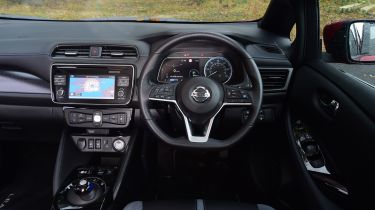Hyundai Kona Electric vs Nissan Leaf: interior, comfort & practicality
The Leaf’s smartphone app is very unreliable, although the Kona Electric is yet to offer such technology

The Hyundai Kona Electric’s SUV bodystyle gives it another advantage in terms of practicality. It’s a little easier to get in and out thanks to the higher roofline and seating. Rear legroom is good in both cars with the Kona probably having a very slight advantage here, too.
In the boot, the Nissan Leaf gets its own back by offering quite a lot more capacity – 435 litres to the Kona’s 332. In both cases, there’s plenty of room for daily duties, but family holidays might put a strain on the Kona’s luggage space.
The Leaf’s interior doesn’t feel as high-tech as the Kona’s, but both cars have issues with material quality, as there are lots of hard plastics. The ergonomics are awkward in the Leaf, the high seat and low steering wheel proving to be a particular problem.
Connectivity & apps
The Leaf’s digital dashboard, is useful but Hyundai offers its own version of this tech with a digital panel showing electric-specific information and offering a similar level of configuration options. The Kona’s main central screen is in a better position than in the Nissan, which places its seven-inch screen too low on the dashboard.
The Kona's screen is bigger (eight inches) and higher-resolution, with a more responsive interface. Nissan offers Apple CarPlay and Android Auto as standard in the Leaf, while the navigation map has charging points and the remaining range overlayed onto it, which is a nice touch.
How good are the apps?
The Leaf has a huge advantage here, as it has an app that you can download for free to an Apple or Android phone. It allows you to check the charging status and set the charging parameters remotely (as well as check that the car’s locked and set the climate control to warm or cool the car ready for your departure time).
However, it's worth pointing out that our experience of living with the car has shown how unreliable the app is. It often has to be updated or reinstalled, and it’s very slow to connect to the car, and sometimes doesn’t connect to the car at all.

You can, of course, set the charging parameters for the Leaf from its in-car touchscreen, which is exactly what you have to do with the Kona, since it doesn’t get an app at all. Company sources have said that a facelift due before 2020 will bring app connectivity for the Kona Electric, but for now you have to use the menus on the screen.
That’s no huge chore, but it is annoying to have to remember to change the settings if you want to deviate from your normal charging regime. For instance, many electric car users normally only charge to 80 or 90% to preserve the battery life, but it’s a shame that the Kona doesn’t allow you to alter that from your phone, as the Leaf does. After all, while the Leaf’s app is a poor effort, it’s better than no app at all.


